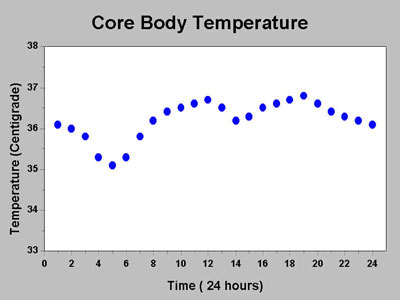Abnormal Development - Maternal Hyperthermia: Difference between revisions
| Line 71: | Line 71: | ||
<pubmed>15703536</pubmed> | <pubmed>15703536</pubmed> | ||
<pubmed>3375545</pubmed> | <pubmed>3375545</pubmed> | ||
<pubmed>6467225</pubmed> | |||
===Search Pubmed=== | ===Search Pubmed=== | ||
Revision as of 12:05, 27 September 2010
Introduction
High core body temperature, hyperthermia, has been shown in animal models to be a potent teratogen. Hyperthermia in humans (greater than 39.5°C/103°F) during the first trimester increases the risk of a miscarriage and neural defects. Hyperthermia can be due to many different factors including: environment, hot tubs, spas, sauna, exercise, infection fever (viral, bacterial), physiological abnormalities of thermoregulation. A difficult associated concept is that of "thermal dose", whereby in experimental conditions the thermal load variables (temperature change, temperature, time) can be highly regulated, in real biological conditions these can be extremely variable including the additional variables of absolute time of exposure and developmental stage.
Guinea pigs have been successfully used as a sensitive model system for the effects of maternal hyperthermia (high body temperature/fever) upon development. This is an example of a maternal environmental effect on embryonic development and neurological effects has also been demonstrated in other rodent model systems.
Some Recent Findings
|
Diurnal Temperature Changes
In humans there are a number of small changes that occur each day and associated with the menstral cycle, neither of which are significant enough to cause hyperthermia.
Firstly there natural diurnal small changes in core body temperature that occur each day.
Secondly, in women of reproductive age there occurs also a small approximately 0.5°C increase in body temperature associated with ovulation during the menstral cycle. This temperature rise is often used in reproductive cycle monitoring to aid or avoid pregnancy.
Neural Tube Defects
Neural tube and other developmental anomalies in the guinea pig following maternal hyperthermia during early neural tube development.[3] "Guinea pigs were exposed to hyperthermia for 1 hr once or twice on day 11, 12, 13, or 14 (E11-E14) of pregnancy. The mean rectal temperatures were elevated by 3.4°C -4.0°C. This treatment resulted in a marked elevation of rates of resorption and developmental defects in embryos examined at day E23. The defects observed were those affecting the neural tube (NTD) (exencephaly, encephaloceles, and microphthalmia), kyphosis/scoliosis, branchial arch defects, and pericardial edema. Embryos with NTD and kyphosis/scoliosis have not been found among newborn guinea pigs to date following maternal heat exposure on days E12-E14. It appears that embryos with these defects are filtered out by resorption or abortion by days E30-E35."
Marsh Edwards
Edwards: discoverer of maternal hyperthermia as a human teratogen.[4] "In a series of animal studies performed over a career spanning 40 years at the University of Sydney, Professor Marshall J. Edwards investigated the hypothesis that maternal hyperthermia during gestation can be teratogenic to the developing fetus. He is one of few investigators to have discovered a known human teratogen primarily through animal studies. His doctoral thesis was entitled "A Study of Some Factors Affecting Fertility of Animals with Particular Reference to the Effects of Hyperthermia on Gestation and Prenatal Development of the Guinea-Pig". He went on to prove that hyperthermia-induced malformations in animals involve many organs and structures, particularly the central nervous system. ... In a series of carefully planned and executed experiments, he demonstrated that the type of defect is related to the timing of the hyperthermic insult, and analyzed the underlying mechanisms.
Pregnancy Exercise Guidelines
American College of Obstetricians and Gynecologists
These new recommendations and guidelines for exercise during pregnancy and the postpartum period were first published in 2002.[5] The recommendations classified absolute and relative contraindications to aerobic exercise during pregnancy. Note that regular exercise is also promoted for overall health benefits including prevention and management of gestational diabetes.
Absolute contraindications include:
- Haemodynamically significant heart disease
- Restrictive lung disease
- Incompetent cervix/cerclage
- Multiple gestation at risk for premature labour
- Persistent second or third trimester bleeding
- Placenta praevia after 26 weeks gestation
- Premature labour during the current pregnancy
- Ruptured membranes
- Pregnancy induced hypertension
Links: PMC1724598 | Br J Sports Med. | PDF
References
- ↑ <pubmed>19180648</pubmed>
- ↑ <pubmed>18983582</pubmed>
- ↑ <pubmed>1354895</pubmed>
- ↑ <pubmed>16265640</pubmed>
- ↑ <pubmed>12547738</pubmed>| PMC1724598 | Br J Sports Med. | PDF
Journals
- International Journal of Hyperthermia There are currently 165 issues available, published between 1985 and 2010.
- The official journal of the Society for Thermal Medicine, the European Society for Hyperthermic Oncology, and the Asian Society of Hyperthermic Oncology, the International Journal of Hyperthermia provides a forum for the publication of Research and Clinical Papers
- Clinical Studies. Whole body, regional or local treatment, practical considerations in therapy, clinical trials, physiological effects, heat treatment in combination with other modalities, thermal ablation and treatment optimization.
- Biological Studies. Mechanisms of thermal injury, thermotolerance, modification of thermal response, heat treatment in combination with other modalities, effects on normal and malignant cells and tissues, immunological effects, physiological effects, thermal dosimetry, drug delivery, gene therapy.
- Techniques of Heat Delivery and Temperature Measurement. Methods of producing whole-body, regional and local hyperthermia; modelling of temperature distributions; performance and evaluation of hyperthermia and thermal ablation equipment; safety and protection; thermal dosimetry; invasive and non-invasive thermometry; calibration; and data acquisition and system control.
Reviews
Articles
<pubmed>16998815</pubmed> <pubmed>16847614</pubmed> <pubmed>1640616</pubmed> <pubmed>15703536</pubmed> <pubmed>3375545</pubmed> <pubmed>6467225</pubmed>
Search Pubmed
June 2010 "Maternal Hyperthermia"
Search Pubmed: Maternal Hyperthermia | thermal dose
External Links
Glossary Links
- Glossary: A | B | C | D | E | F | G | H | I | J | K | L | M | N | O | P | Q | R | S | T | U | V | W | X | Y | Z | Numbers | Symbols | Term Link
Cite this page: Hill, M.A. (2024, April 18) Embryology Abnormal Development - Maternal Hyperthermia. Retrieved from https://embryology.med.unsw.edu.au/embryology/index.php/Abnormal_Development_-_Maternal_Hyperthermia
- © Dr Mark Hill 2024, UNSW Embryology ISBN: 978 0 7334 2609 4 - UNSW CRICOS Provider Code No. 00098G

